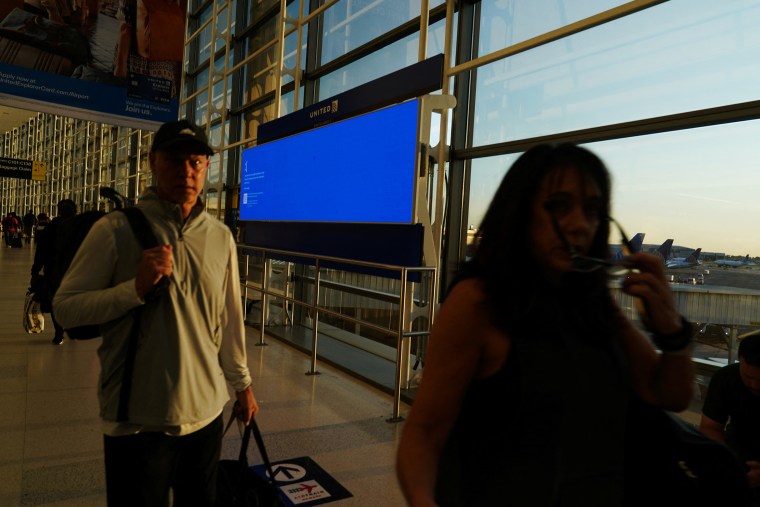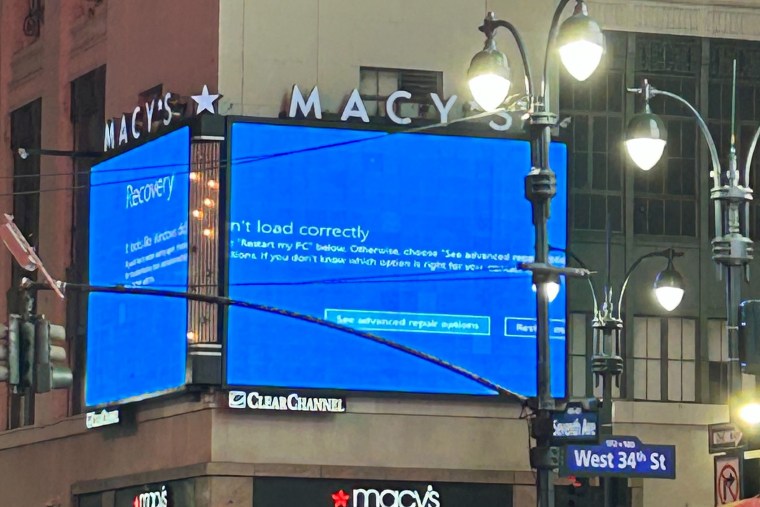An image that has instilled panic in computer users for decades popped up on screens worldwide Friday: the dreaded “Blue Screen of Death.”
Appearing everywhere from Macy’s flagship store in New York City to airports in India, the Blue Screen of Death has long prompted groans and frantic questions of “Did my work save?” It’s a Microsoft Windows error screen indicative of a system crash — meaning a computer issue has resulted in the operating system no longer being able to run safely.
An unwanted sight that has become so widely known over its more than 30-year existence, it’s sometimes referred to by its acronym, BSoD. On Friday, the blue screen taunted millions globally amid a widespread technology outage that halted flights, knocked broadcasters off the air and disconnected some emergency phone lines. Texas-based cybersecurity firm CrowdStrike said early Friday that the outage was the result of a “defect found in a single content update for Windows hosts,” not a cyberattack, and that a fix had been deployed.
Retired Microsoft software engineer David Plummer said that while the BSoD has always been synonymous with tech trouble on individual computers, “to have everybody having a blue screen at once is very uncommon.” He added that it’s not always something complex that leads to a blue screen, but “it has to be a failure in a place where the system has no other alternatives.”

The Blue Screen of Death has evolved over the years from a rudimentary message to today’s display, which remains simple enough to immediately inform whoever is looking at it that they’re in for some technological hassles. The blueness of the screen has also changed: Once a royal blue, the background color has morphed to cerulean. Some past operating systems, such as Windows 95 and 98, allowed users to customize the screen away from blue altogether for those who wanted to associate another color with misery.
Mar Hicks, a historian of technology and an associate professor at the University of Virginia's School of Data Science, said the Blue Screen of Death has become a cultural icon that strikes terror in nearly every computer user.
"Pretty much anybody, regardless of their level of computer savviness, knows that when you see that traditional old-school Blue Screen of Death, something has gone very badly wrong," Hicks said.
Despite its ubiquity, much is unknown about the origins of the Blue Screen of Death. Even its original creator is somewhat elusive: After it was widely credited in September 2014 to former Microsoft CEO Steve Ballmer in publications including Business Insider, Gizmodo and Engadget, another former Microsoft employee, Raymond Chen, claimed that he had been the one to create the original blue screen. Plummer said he thought it was former Microsoft developer John Vert, who has taken ownership credit for the blue screen in a post on the crowdsourcing site Quora, writing that he wrote the original code for Window NT 3.1 (the “NT” stood for “new technology”) in 1991.
In a direct message sent to NBC News via X, Vert said there was no single creator.
"I implemented the code for Windows NT 3.1. Other versions of Windows like Windows 95 or 16-bit Windows had different things done by different people," he wrote. "So if you are looking for one 'creator' there is no such thing."

And a similar screen preceded the Windows NT Blue Screen of Death, Plummer said, further adding to the confusion.
“There was a blue screen in the Windows of the older days of the ‘80s,” he said. “The one that we are hitting today just happens to be the same color in the same situation, but it’s a different scenario.”
CrowdStrike CEO and co-founder George Kurtz told NBC’s “TODAY” show on Friday that the company was “deeply sorry” to those impacted.
But the problem clearly wasn’t something that Control+Alt+Delete could quickly resolve: Kurtz warned that although a fix had been deployed, “it could be some time” before all systems were back up and running.
